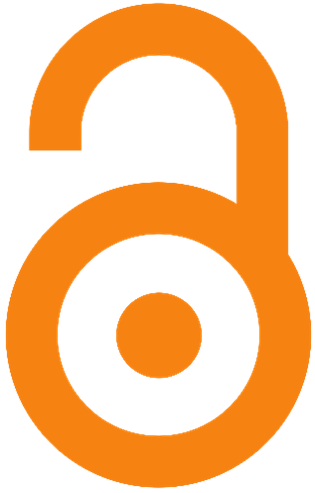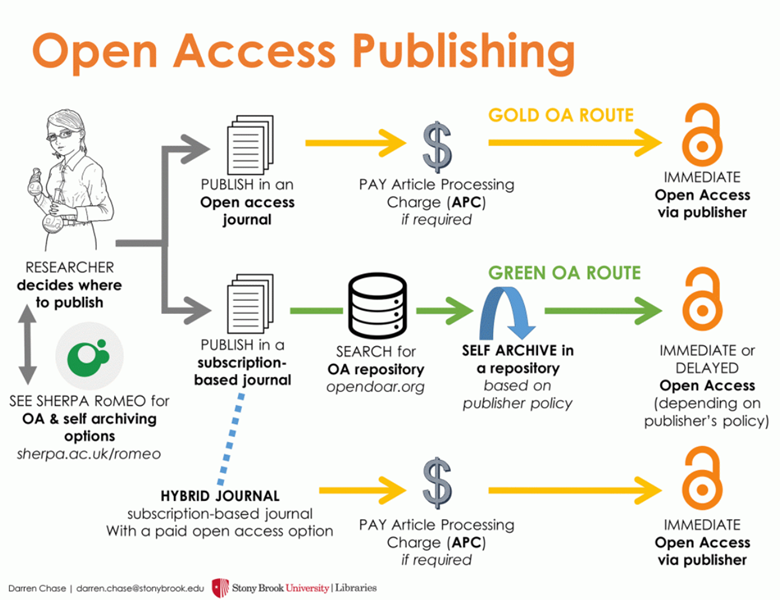What Is Open Access?

Photo by Viktor Forgacs on Unsplash
Open Access (OA) is a concept for the distribution and use of scholarly literature, including scientific research. It is similar in concept to the Open Source movement which is a model for the distribution and no-user-cost for software applications. OA is a broad international movement that seeks to grant free and open online access to academic information and data.
Key components of OA are the removal of price and permission barriers. Open Access materials are free to the audience, or end user, and the end user is able to use and reproduce, and sometimes modify (i.e. create derivative works from) the literature without permission from the original author. Sometimes OA is called an “author pays” model, because the author or their institution pays for the publication costs, not the end users. Under Open Access, the author does not give up copyright to their work, rather, they grant broad permission to access and use their work under special licensing. It is not Napster for academic and scientific literature, but a legal way for researchers to publish their work and share it broadly with the world.

Why would a scientist conducting research at a post-secondary institution want to grant free and open access to their work? After all, the research and literature are not free to produce. To understand the OA movement, it is important to first understand how traditional academic publishing works. Until the mid-seventeenth century, academic publishing did not exist in any organized format. Scientists and academics attempting to publish and share their work often met with resistance and sometimes ridicule (New World Encyclopedia, 2021). It wasn’t until the Royal Society began to publish Philosophical Transactions in 1665 that research discoveries began to enjoy less dispute and more widespread acceptance (New World Encyclopedia, 2021). Many authors such as Isaac Newton, Michael Faraday, and Charles Darwin advanced their careers through publishing in Philosophical Transactions (New World Encyclopedia, 2021).
The Royal Society established the critical role of academic publishing in the open exchange of research and new ideas. In the twentieth century, especially post-WWII, academia became commercialized, as did academic publishing (Fyfe, A., et al., 2017). In fact, publishing became a key component in an academic institution’s prestige, which was important in attracting both researchers and students (and their tuition dollars!) to an institution. This was largely done through the use of peer review. The Royal Society introduced peer review to legitimize scholarship however commercial publishers implemented peer review as a prestige-generating tool for academic institutions (Fyfe, A., et al., 2017). Peer review is a method by which scholarly and scientific research is evaluated by other researchers in the same field as the author. It is a rigorous process involving analysis, revisions, and acceptance or rejection of a researcher’s findings. Another value-added feature commercial academic publishers have marketed is impact factor. Complex algorithms are used to measure factors such as citation frequency to rate authors.
This commercialized model of academic publishing has shaped the way research is shared and accessed to this day. Essentially, research is funded largely by post-secondary institutions and government grants. Large commercial academic publishers, such as Elsevier, SAGE, and Wylie review the research submissions from academics and scientists and accept or reject the work. Once accepted, the original research is published then sold back to the universities in the form of licensed access to academic journals. These large-scale academic publishers help researchers access a worldwide audience for their research. Most of the physical (paper) journals have been replaced with digital databases, but the commercial model has remained the same for the last 70 years. Increasing costs of commercial academic journals in combination with decreasing budgets in academic libraries have resulted in a push for alternative publishing models. OA is one popular alternative.
OA also utilizes peer review, although there was time of pioneering in the 1990’s and then innovation in the early 2000’s in which OA had to prove its peer review as well as build global exposure to compete with the big commercial academic publishers. A prominent OA directory is the Directory of Open Access Journals (DOAJ), through which over 6 million articles may be found. Many academic institutions host Open Access repositories and open journal hosting, including Mount Royal University and the University of Calgary.

 There are two formats to OA publishing called Green and Gold. Gold OA involves publishing costs (Article Processing Charges) that are usually paid by the author or their institution, and the publications are usually accessible immediately (Jisk, 2019). Green OA differs from Gold in that no charges are paid, and the work is published in a journal but also in an OA repository (Jisk, 2019).
Often with Green OA there is an embargo (a period of time with no access or paid access only) set by the publisher. Another important difference is that in Gold OA copyright is retained by the author and in Green OA copyright sits with the publisher. The infographic below charts out this process (note – Sherpa Romeo is a resource that aggregates and analyses worldwide publisher open access policies to guide researchers in their choice of publisher):
There are two formats to OA publishing called Green and Gold. Gold OA involves publishing costs (Article Processing Charges) that are usually paid by the author or their institution, and the publications are usually accessible immediately (Jisk, 2019). Green OA differs from Gold in that no charges are paid, and the work is published in a journal but also in an OA repository (Jisk, 2019).
Often with Green OA there is an embargo (a period of time with no access or paid access only) set by the publisher. Another important difference is that in Gold OA copyright is retained by the author and in Green OA copyright sits with the publisher. The infographic below charts out this process (note – Sherpa Romeo is a resource that aggregates and analyses worldwide publisher open access policies to guide researchers in their choice of publisher):

Another way to understand Open Access publishing is to review its benefits and disadvantages.
Following is a summary of Open Access advantages:
- Because of the removal of cost barriers, authors’ work is exposed to a wider global audience,
- OA published articles are subject to peer review,
- The spirit of transparent access to original research, and free exchange of ideas is supported – OA provides an impetus for knowledge-sharing,
- Research produced in part by public funding is more accessible to taxpayers
- Research can be accessed by the general public and business, instead of confined to post-secondary academic circles, and
- OA can be easily copied and used in derivative works, which makes it easier to adapt to teaching.
(Open Access, n.d.)
Despite its appeal, there are some disadvantages to Open Access publishing:
- OA is relatively new, and does not carry the prestige and established impact factor analysis of traditional commercial academic publishing,
- The number of OA journals across different disciplines varies widely,
- Funding can be difficult to secure for individual authors,
- Authors can be spammed by “Open Access” publishers of dubious quality, sometimes called “predatory publishers” (locating an OA publisher in DOAJ or Sherpa Romeo can help authors check a publisher’s legitimacy),
- There is often more work for the authors in supplying publication data and full text to OA publishers, and
- Sometimes there are copyright barriers associated with some repositories in Green OA.
(Open Access, n.d.)
Although OA publishing access has been around for several decades, it is still not completely understood or leveraged by many authors and end users. It is, however, gaining some traction in many disciplines. For example, researchers in physics, math, astrology and biology often publish through Green OA, and medical science scholars are increasingly publishing through gold OA (Severin et al., 2020). This is very good news for business and individuals, and indeed some post-secondary libraries, who cannot afford to access research through academic commercial publishing licences but can still utilize, and benefit from, post-secondary research.
References
Chase, D. (2021). Open Access Publishing. Retrieved from https://library.stonybrook.edu
scholarly-communication/open-access/
Forgacs, V. (2020). [Neon open sign] [Photograph]. Unsplash. Retrieved from
https://unsplash.com/photos/LNwIJHUtED4
Fyfe, A. , Coate, K., Curry, S., Lawson, S., Moxham, N., and Mørk Røstvik, C. (2017).
Untangling Academic Publishing. Retrieved from
https://eprints.bbk.ac.uk/id/eprint/19148/1/UntanglingAcPub.pdf
Jisc. (2019, October 17). An Introduction to Open Access. Retrieved from
https://www.jisc.ac.uk/guides/an-introduction-to-open-access
New World Encyclopedia. (2021). Academic publishing. In newworldencyclopedia.com. Retrieved from
https://www.newworldencyclopedia.org/entry/Academic_publishing
Open Access. (n.d.). Pros and cons. Retrieved from
https://www.openaccess.nl/en/what-is-open-access/pros-and-cons
Severin A., Egger M., Eve M.P., and Hürlimann D. (2020). Discipline-specific open access
publishing practices and barriers to change: an evidence-based review. F1000Research, 7:1925
(https://doi.org/10.12688/f1000research.17328.2)